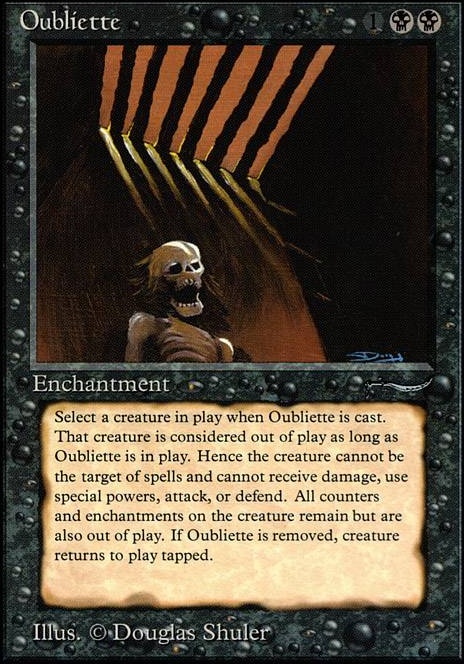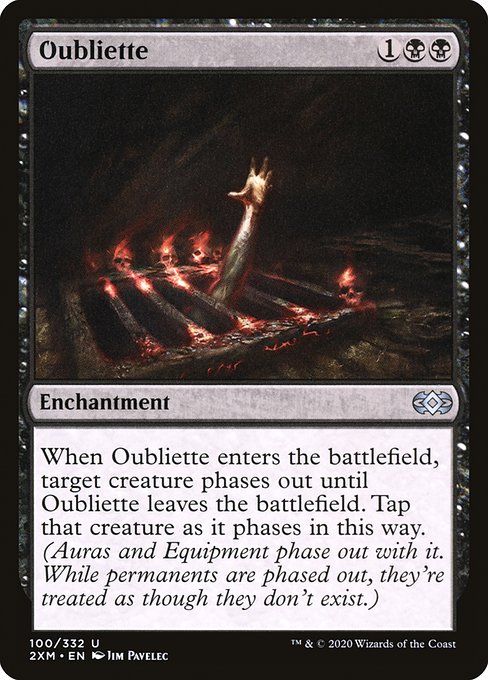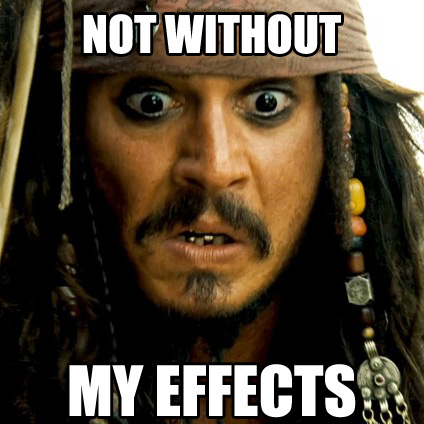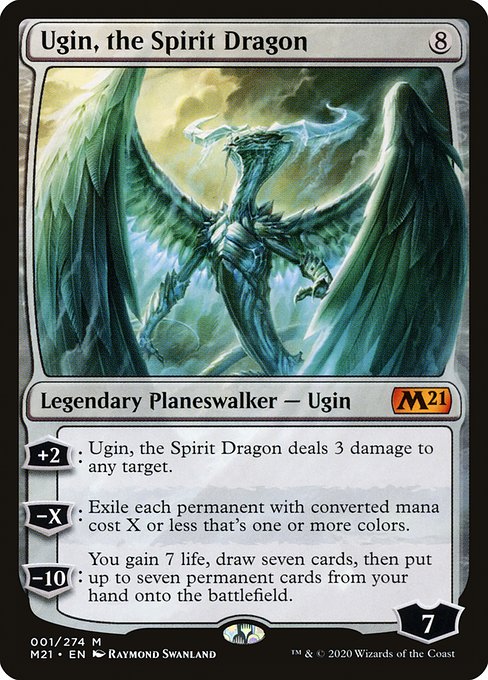Kristen sits down to discuss Oubliette’s new rules text and what this means for the Commander format. Cover art by @ADuelista
One of the most exciting reprints in Double Masters isn’t a mythic. It’s not even a box topper. It’s a Pauper staple, printed at uncommon. It’s Oubliette. Over the course of this article, we’re going to look at the errata, what that changes, how it works with the Command Zone, and how similar cards to this tend to play out. We’re also going to say the word Oubliette so many times it won’t sound like a word anymore. Ready? Good. Let’s go.

Oubliette before it received an Errata
Oubliette
Oubliette read very differently before the new printing in Double Masters. Functionally, it treated the creature as though it were exiled, but tracked the auras and counters on the creature before it went to exile, and ensured that, when it returned to play after Oubliette left play, it would return with those additional pieces still attached. It was clunky, overly wordy, and in many ways didn’t make sense; why would it track auras, but not equipment? Is it because they’d confiscate your sword before throwing you in the Oubliette? Well, probably, but that’s beside the point. It’s definitely not because equipment didn’t exist back then.
Under the old rules text for Oubliette, if it targeted your Commander, it would trigger an exile, which would allow you to use the replacement effect to put your Commander in the Command Zone instead. So, what’s changed?

Oubliette now reads that the creature phases out until Oubliette leaves play. This actually changes quite a lot about the card when it comes to Commander. The change to phasing means that the creature now will keep any equipment that was attached to it. So, if you have a lovely Sword of Fire and Ice attached to your creature, well, say goodbye to the sword until the creature phases back in.

It’s not the only change though, and the main change is actually more impactful than this. Because the creature now doesn’t go to exile—because it doesn’t leave the battlefield—there is now no zone change taking place. Ergo, if your Commander doesn’t change zones, you can’t put it back into your Command Zone. This makes Oubliette a powerful piece of removal, and one that many people will be excited to play.
Oubliette now becomes a brilliant answer for Black decks that want to deal with Voltron—all of the scary equipment attached to the beatstick will now be phased out too, meaning they can’t just strap up a replacement creature. It also stops opponents from reanimating a dead creature, and it also stops enter-the-battlefield triggers from happening too. For three mana, it’s a pretty decent effect, and a lot stronger in many ways than the like of Banishing Light.
Why might this be an issue?
There will inevitably be games where a players Red or Black Commander is phased out with Oubliette and it doesn’t come back until the game is over. That might sound like hyperbole, but when you’re discussing the floor and ceiling of a card, you do have to consider the outlier outcomes to truly gauge the effect a card will have. While there will be games where other decks will board wipe all of the enchantments away, or you’ll be able to politic your way to someone removing Oubliette as a favor; there will be just as many where the table will collectively decide they’d rather not deal with your Commander at all, and elect to not help you out.
There will also likely be games where your Commander has no real chance to do anything thanks to an early Oubliette, leading to a win from another player. In both of these scenarios, whether you value winning as your fun factor, or the more sociable “everyone gets to do their thing,” it doesn’t really matter; Oubliette can lead to games where neither happen for the player affected.
So why would this happen?
Well, to put it simply, there are two colors that will struggle to deal with an Oubliette: Red and Black. Where White and Green can destroy or exile enchantments, and Blue can bounce or counter them, Red and Black have very limited answers at an efficient mana cost. Cards like Pharika’s Libation and Mire in Misery require the board to be in a very specific configuration to work; and beyond Chaos Warp, Red only has the expensive options that other colors have.

There are ways to remove it, though. All is Dust, Ugin, the Spirit Dragon, and Ugin, the Ineffable can all get rid of an Oubliette. Meteor Golem, Spine of Ish Sah, and Boompile all work too, and so do Nevinyrral’s Disk and Oblivion Stone. There are probably more, but you might be seeing a pattern: all of these cards either cost a huge amount of mana, or are a nuclear option that decimates your own board too. You can always remove the player who played it too. Player removal is my favorite type of removal.
All said and done, it can be a struggle for Red and Black decks to deal with Oubliette. But Kristen, I hear you say, don’t we already have enchantments like this in the format? Cards like Nevermore, Darksteel Mutation, and Imprisoned in the Moon? Well, yes. But these aren’t quite the same.
One of these cards is not like the others
Let’s just run through some of these other Enchantments and compare them to Oubliette:
- Nevermore sees very little play outside of more competitive tables, and is considered by many an unfun card. It also doesn’t really have an impact if a Commander is already cast, and isn’t removal in its own right. Oubliette, on the other hand, is an uncommon reprint that is efficient removal that can be played at any number of tables.
- Imprisoned in the Moon and Song of the Dryads both turn the creature into a land. Any deck worth its salt runs land destruction; and even beyond Ghost Quarter in the manabase, red has access to spells like Volcanic Offering, Pillage, and Red Elemental Blast to deal with these effects. Black has access to effects like Sinkhole too.
- Lignify and Darksteel Mutation may be annoying, but the creature is still in play. That means it can be hit by edicts, it can be sacrificed, and it can be targeted with exile removal. Red even has access to damage wraths and single target burn spells that can remove indestructible. There are many highly played ways to interact with a permanent in play that are playable in all colors, like High Market, Altar of Dementia, Ashnod’s Altar, and so on. Many mono-red and mono-black decks already play these, and within their own colors, they also have access to the likes of Goblin Bombardment and Vampiric Rites.
Whilst some of these effects can be used proactively when Oubliette is played—like sacrificing the creature in response—they can also be used re-actively when drawn into later in the game. In the case of Oubliette, these effects aren’t applicable. We’ve yet to see how popular Oubliette will be, but it’s a safe assumption to make that these existing spells will be less ubiquitous than Oubliette given how good the new rules text on Oubliette is.
Who will Oubliette effect?
Well, it’s unlikely to affect the cEDH community. Another tool to remove troublesome Commanders is actually right up their alley. Given most decks in the format are three or more colors, removing enchantments with Disenchant or Nature’s Claim is already very easy.
I also think, for the most part, that this will have a low impact on enfranchised players that are active within the community. These players are far more willing to enjoy and engage in the politics side of gameplay, and help out a player who is struggling. They’re also the kind to have rule zero discussions; and, if a player really wants to play their Neheb, the Eternal deck, are unlikely to all pull out Black decks just to hose them.
It’s worth noting, mentioning Neheb, that these are the kinds of decks most affected by Oubliette. Red and Black decks that heavily rely on their Commander to function will definitely see some hurdles, and so Commanders like Neheb, K’rrik, Son of Yawgmoth, Rakdos, Lord of Riots, Greven, Predator Captain, Purphoros, God of the Forge, Zada, Hedron Grinder, and Syr Konrad the Grim will feel the most hard done by. My own deckbuilding philosophy is that decks should be able to function and even win without their Commander in play; but “all in” strategies are fun from time to time, and it’s not fair to say that these decks should unduly struggle just because of the color(s) they’ve chosen.
Beyond the more specific Commander-centric strategies in Red and Black, the main player base that this will likely affect is the casual playerbase. Oubliette has the potential to be a feels-bad card, one that can cause players to come out of a game feeling hard done by and also questioning the worth of their Red and Black decks. It will provide some level-up moments in deckbuilding, but at the same time, might put more casual players off from building decks entirely if the card is ubiquitous in their playgroup.
Hang on, didn’t the RC just change death rules to be more easily worked to make things more fun?
Yes, they did. Recently, the rules around a Commander dying changed to allow death triggers to work. This was to open up more Commanders for people to play, allowing cards like Elenda, the Dusk Rose to shine. Now, when a Commander dies, it does hit the graveyard briefly before the decision to change zone happens. This decision was made to make the format more accessible in the same way that changing the infamous tuck rule did. For the uninitiated, it used to be possible to use a card like Terminus or Chaos Warp to shuffle a Commander into a library. Super unfun!
Why is this relevant? Well, with the ruling change on how Oubliette works, phasing works more similarly to tucking a Commander, at least for Red and Black decks. It also runs counter to the accessibility and fun aspects that are at the forefront of the format, driving the Rules Committee to change the dies rule.
All in all, that makes Oubliette a really interesting case. It’s obviously way too early to make any decision as to how this may play out, and way too early to truly see the impact this might have on the format, but it bears thinking about at the very least. I’m willing to see how it pans out, and you should be too. For now, if you haven’t already seen the hilarious Oubliette reveal video from Tolarian Community College, check it out below:
I hope this article has spurred some engaging thought exercises for you, and that it also goes some way to relieving pressure from the CAG and RC on social media—believe me, they’ll be way more interested in discussing things if you can demonstrate a keener understanding of the intricacies surrounding controversial cards than if you go in guns blazing. Let me know on Twitter what you think!
Based in the UK, Kristen is a lover of both Limited and Commander, and can most often be found championing the Boros Legion when called upon to sit down and shuffle up.

